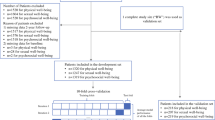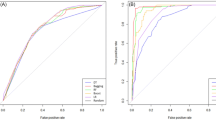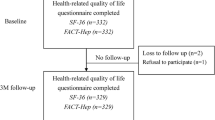Abstract
Purpose
The goal was to develop models for predicting long-term quality of life (QOL) after breast cancer surgery.
Methods
Data were obtained from 203 breast cancer patients who completed the SF-36 health survey before and 2 years after surgery. Two of the models used to predict QOL after surgery were artificial neural networks (ANNs), which included one multilayer perceptron (MLP) network and one radial basis function (RBF) network. The third model was a multiple regression (MR) model. The criteria for evaluating the accuracy of the system models were mean square error (MSE) and mean absolute percentage error (MAPE).
Results
Compared to the MR model, the ANN-based models generally had smaller MSE values and smaller MAPE values in the test data set. One exception was the second year MSE for the test value. Most MAPE values for the ANN models ranged from 10 to 20 %. The one exception was the 6-month physical component summary score (PCS), which ranged from 23.19 to 26.86 %. Comparison of criteria for evaluating system performance showed that the ANN-based systems outperformed the MR system in terms of prediction accuracy. In both the MLP and RBF networks, surgical procedure type was the most sensitive parameter affecting PCS, and preoperative functional status was the most sensitive parameter affecting mental component summary score.
Conclusion
The three systems can be combined to obtain a conservative prediction, and a combined approach is a potential supplemental tool for predicting long-term QOL after surgical treatment for breast cancer.
Relevance
Patients should also be advised that their postoperative QOL might depend not only on the success of their operations but also on their preoperative functional status.

Similar content being viewed by others
References
Shi HY, Uen YH, Yen LC, Culbertson R, Juan CH, Hou MF (2011) Two-year quality of life after breast cancer surgery: a comparison of three surgical procedures. Eur J Surg Oncol 37(8):695–702
Bogaarts MP, Den Oudsten BL, Roukema JA, Van Riel JM, Beerepoot LV, De Vries J (2011) Development of the Psychosocial Distress Questionnaire-Breast Cancer (PDQ-BC): a breast cancer-specific screening instrument for psychosocial problems. Support Care Cancer 19(10):1485–1493
Van Esch L, Roukema JA, Van der Steeg AF, De Vries J (2011) Trait anxiety predicts disease-specific health status in early-stage breast cancer patients. Qual Life Res 20(6):865–873
Cohen M, Mabjish AA, Zidan J (2011) Comparison of Arab breast cancer survivors and healthy controls for spousal relationship, body image, and emotional distress. Qual Life Res 20(2):191–198
van Hezewijk M, Hille ET, Scholten AN, Marijnen CA, Stiggelbout AM, van de Velde CJ (2011) Professionals' opinion on follow-up in breast cancer patients; perceived purpose and influence of patients' risk factors. Eur J Surg Oncol 37(3):217–224
Zimmermann C, Burman D, Swami N, Krzyzanowska MK, Leighl N, Moore M, Rodin G, Tannock I (2011) Determinants of quality of life in patients with advanced cancer. Support Care Cancer 19(5):621–629
Roundtree AK, Giordano SH, Price A, Suarez-Almazor ME (2011) Problems in transition and quality of care: perspectives of breast cancer survivors. Support Care Cancer 19(12):1921–1929
Taira N, Shimozuma K, Shiroiwa T, Ohsumi S, Kuroi K, Saji S, Saito M, Iha S, Watanabe T, Katsumata N (2011) Associations among baseline variables, treatment-related factors and health-related quality of life 2 years after breast cancer surgery. Breast Cancer Res Treat 128(3):735–747
Delen D, Walker G, Kadam A (2005) Predicting breast cancer survivability: a comparison of three data mining methods. Artif Intell Med 34(2):113–127
Ayer T, Alagoz O, Chhatwal J, Shavlik JW, Kahn CE Jr, Burnside ES (2010) Breast cancer risk estimation with artificial neural networks revisited: discrimination and calibration. Cancer 116(14):3310–3321
Hui EP, Leung LK, Poon TC, Mo F, Chan VT, Ma AT, Poon A, Hui EK, Mak SS, Lai M, Lei KI, Ma BB, Mok TS, Yeo W, Zee BC, Chan AT (2011) Prediction of outcome in cancer patients with febrile neutropenia: a prospective validation of the Multinational Association for Supportive Care in Cancer risk index in a Chinese population and comparison with the Talcott model and artificial neural network. Support Care Cancer 19(10):1625–1635
Abernethy AP, Etheredge LM, Ganz PA, Wallace P, German RR, Neti C, Bach PB, Murphy SB (2011) Rapid-learning system for cancer care. J Clin Oncol 28(27):4268–4274
Osoba D, Rodrigues G, Myles J, Zee B, Pater J (1998) Interpreting the significance of changes in health-related quality-of-life scores. J Clin Oncol 16(1):139–144
Yu J, Coons SJ, Draugalis JR, Ren XS, Hays RD (2003) Equivalence of Chinese and US-English versions of the SF-36 health survey. Qual Life Res 12(4):449–457
Yarlas AS, White MK, Yang M, Saris-Baglama RN, Bech PG, Christensen T (2011) Measuring the health status burden in hemodialysis patients using the SF-36® health survey. Qual Life Res 20(3):383–389
Fuh JL, Wang SJ, Lu SR, Juang KD, Lee SJ (2000) Psychometric evaluation of a Chinese (Taiwanese) version of the SF-36 health survey amongst middle-aged women from a rural community. Qual Life Res 9(6):675–683
Rumelhart DE, Hinton GE, Williams RJ (1986) Learning internal representations by error propagation. In: Rumelhart DE, McClelland JL (eds) Parallel distributed processing: explorations in the microstructure of cognition. MIT, Cambridge, pp 318–362
Haykin S (1999) Neural networks: a comprehensive foundation, 2nd edn. Prentice-Hall, Englewood Cliffs
Sandberg IW, Lo JT, Fancourt CL, Principe JC, Katagiri S, Haykin S (2001) Nonlinear dynamical systems: feedforward neural network perspectives. Wiley, UK
Lee TY, Chen SA, Hung HY, Ou YY (2011) Incorporating distant sequence features and radial basis function networks to identify ubiquitin conjugation sites. PLoS One 6(3):e17331
Poggio T, Girosi F (1990) Regularization algorithms for learning that are equivalent to multilayer networks. Science 247(4945):978–982
Wei CH, Lee Y (2007) Sequential forecast of incident duration using artificial neural network models. Accid Anal Prev 39(5):944–954
Acknowledgments
This work is partially supported by the National Science Council, Taiwan, Republic of China, under grant numbers NSC100-2221-E-153-001 and NSC99-2314-B-037-069-MY3.
Conflict of interest
Drs. Jinn-Tsong Tsai, Ming-Feng Hou, Yao-Mei Chen, Thomas T. H. Wan, Hao-Yun Kao, and Hon-Yi Shi have no conflicts of interest or financial ties to disclose.
Author information
Authors and Affiliations
Corresponding author
Appendices
Appendix 1
Appendix 2
Rights and permissions
About this article
Cite this article
Tsai, JT., Hou, MF., Chen, YM. et al. Predicting quality of life after breast cancer surgery using ANN-based models: performance comparison with MR. Support Care Cancer 21, 1341–1350 (2013). https://doi.org/10.1007/s00520-012-1672-8
Received:
Accepted:
Published:
Issue Date:
DOI: https://doi.org/10.1007/s00520-012-1672-8




